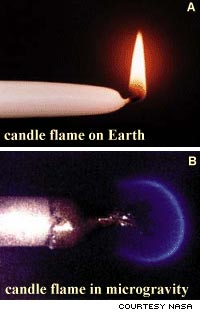learning time!
one day, i wondered to myself: What is fire? seriously, what EXACTLY is fire? can you define it for me? we can easily define water. it's H2O. liquid. has mass, and is tangible. is fire tangible? we can feel it's heat, but we can't grasp it. what is it made of? and don't say fire! silly bastards. ;) remember what your teacher says: it's not a real definition if you put any form in the word your are defining into the definition.
SO! i decided to use the internet. i don't know if i found this article through jeeves or google, but what matters most is that i found it. i found a competent answer. so here you go. and some cool pics of fire in a vacuum. :D
Dear Cecil:
What exactly is fire? I know it's combustion of fuel, blah, blah . . . but what is it exactly? Is it purely energy? What state of matter is it? I suspect it's highly energetic gases, whose energy state is so high that they emit light, and thus we see flame, with the hotter flames being higher in electromagnetic energy. But I've never seen any source explaining exactly what fire is. Can it be ionized? Can it be affected by magnetism? Gravity? --Wenhsingyu
Cecil replies:
This letter shows why the world needs me. The explanations of fire in most standard reference works, not to put too fine a point on it, suck. The Encyclopaedia Britannica, for example, takes the following ineffectual stab: "rapid burning of combustible material with the evolution of heat and usually accompanied by flame." No wonder people have lost faith in science. Time to let a professional show how it's done. We'll start by reviewing the defects of the EB definition.
(1) Rapid burning. OK, fire burns rapidly. Slow combustion, also known as oxidation, includes such nonfiery processes as rusting and digestion. However, to say that fire involves burning is to embark on a circular definition: What is fire? When something burns. What is burning? When something is on fire. We need to address the matter in more basic terms.
(2) Combustible materials. Redundant. If a material is capable of rapid burning, by definition it's combustible. Also, "materials" is needlessly vague. One specific material, oxygen, is always involved.
(3) Evolution of heat. I don't know what this is supposed to mean either.
(4) Usually accompanied by flame. "Usually accompanied by" my arse. Flame is the quintessential pyrolytic phenomenon, not a mere by-product.
Now for a proper definition, devised by myself: "Fire is the rapid combination of oxygen with fuel in the presence of heat, typically characterized by flame, a body of incandescent gas that contains and sustains the reaction and emits light and heat." Let's go through this bit by bit:
(1) Rapid combination of oxygen with fuel in the presence of heat. Oxygen, fuel, and heat are the essential ingredients of fire.
(2) Typically characterized by flame. The pup qualifier "typically" allows me to sidestep the issue of apparently nonflaming fires, like you get with burning charcoal. I suspect charcoal fires do create flame--you just can't see it due to the lack of impurities or incompletely burned fuel in the plume. (You can't see a fuel fire at an Indy or CART race either, because the cars run on clean-burning methanol.) But that's a matter we can leave for another day.
(3) Body of incandescent gas. Flame defined. Most encyclopedia and dictionary definitions blow past this entirely, allowing persons such as yourself to imagine that fire is "pure energy" or similar nonsense. We say "body" because the gas has a characteristic structure and composition. We say "incandescent" because (a) it sounds scientific, (b) it means "luminous with intense heat," precisely what we are attempting to convey, and (c) if the Teeming Millions are going to learn one vocabulary word today, by God "incandescent" should be it.
(4) Contains and sustains the reaction. Flame isn't just the result of fire; it is the fire. What's more, without the flame's heat the fire would go out.
(5) Emits light and heat. Duh. However, we mustn't overlook the obvious.
Now to your other questions:
-Is fire purely energy? Clearly not. The dancing flames are glowing gas--your suspicions confirmed.
-Can fire be ionized? Is it affected by magnetism? Not so's you'd notice. You're thinking of plasma, which is ionized (and thus electromagnetically reactive) gas, often described as the fourth state of matter. You see it in welding arcs, lightning bolts, and the sun. Ordinary fire isn't plasma.
-Is fire affected by gravity? Of course--gas has mass. Flame is shaped by convection, a function of gravity (hot air rises). In low- or zero-G environments, fire looks way different: a candle flame on the space shuttle isn't yellow and tapered but blue and nearly spherical.
So there you have it. One step closer to a better world.
--CECIL ADAMS


so there it is! fire revealed! how awesome was that? i was enlightened. hahaha. thank you to nasa and most importantly to cecil adams, whoever and wherever you are! :D

3 eh!
wow fatima,
you and i both seem to have a lot of time on our hands as of late. come over to SoCal!! hehe...take care =)
-carla
11/12/2005 5:53 PM
carla! wutcha doin january 19-22? i'm goin to vegas! wanna meet up? do some damage? ;)
11/17/2005 2:35 PM
oooh sounds good--no plans as of yet, but i will definitely consider. i'll tell missy and krystle for sure. haha, do damage? why fatima, what ever do you mean? =P
11/21/2005 1:18 AM
Post a Comment
<< Home